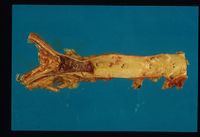Introduction
As the name implies, a thromboembolism is a clot (thrombus) or foreign body that blocks vessels a distance away from its site of origin. The most significant sites of thromboembolic formation are the following: lungs, CNS, terminal aorta, kidneys.
In order for a thromboembolism to occur, some changes in the vasculature need to be present. These include disruption of endothelial integrity, disruption of flow, disruption of blood haemostasis and disruption of fibrinolysis.
The incidence of thromboembolism greatly increases with certain diseases including heart disease, neoplasia, blood disorders, parasitic diseases and hyperadrenocorticism.
Clinical Signs
The '5 P's' are the characteristic clinical signs of thromboembolism. These are pain, paresis, pallor, pulselessness and polar (cold extremities). Long term clinical effects include necrosis of the affected area. Specific clinical signs relating to the thromboembolism being in a particular area include acute onset neurological problems, renal failure if clot in kidneys and dyspnoea if it is in the lungs.
Diagnosis
All findings and diagnostic procedures are heavily dependent on the site affected.
Blood tests may reveal hyperkalemia, acidosis, increased lactate, azotemia and elevated serum creatine phosphokinase. Radiography, echocardiography and angiography may also be used to diagnose a thromboembolism.
Treatment
It is important to treat the underlying conditions. Pain relief is vital and must be very strong, e.g. morphine. I.V. fluids will also need to be given as supportive treatment. Anticoagulants, heparin or aspirin, should also be given.
Prognosis
Prognosis is grave in most cases.
| Thromboembolism Learning Resources | |
|---|---|
 Full text articles available from CAB Abstract (CABI log in required) |
Feline thromboembolism. Moïse, N. S.; The North American Veterinary Conference, Gainesville, USA, Small animal and exotics. Proceedings of the North American Veterinary Conference, Volume 22, Orlando, Florida, USA, 2008, 2008, pp 229-232 |
References
Ettinger, S.J. and Feldman, E. C. (2000) Textbook of Veterinary Internal Medicine Diseases of the Dog and Cat Volume 2 (Fifth Edition) W.B. Saunders Company
Ettinger, S.J, Feldman, E.C. (2005) Textbook of Veterinary Internal Medicine (6th edition, volume 2) W.B. Saunders Company
Fossum, T. W. et. al. (2007) Small Animal Surgery (Third Edition) Mosby Elsevier
Merck & Co (2008) The Merck Veterinary Manual (Eighth Edition) Merial
Nelson, R.W. and Couto, C.G. (2009) Small Animal Internal Medicine (Fourth Edition) Mosby Elsevier.
| This article has been peer reviewed but is awaiting expert review. If you would like to help with this, please see more information about expert reviewing. |
Error in widget FBRecommend: unable to write file /var/www/wikivet.net/extensions/Widgets/compiled_templates/wrt693bed54756c06_10800397 Error in widget google+: unable to write file /var/www/wikivet.net/extensions/Widgets/compiled_templates/wrt693bed547b1131_98656268 Error in widget TwitterTweet: unable to write file /var/www/wikivet.net/extensions/Widgets/compiled_templates/wrt693bed547f6b50_52539232
|
| WikiVet® Introduction - Help WikiVet - Report a Problem |
